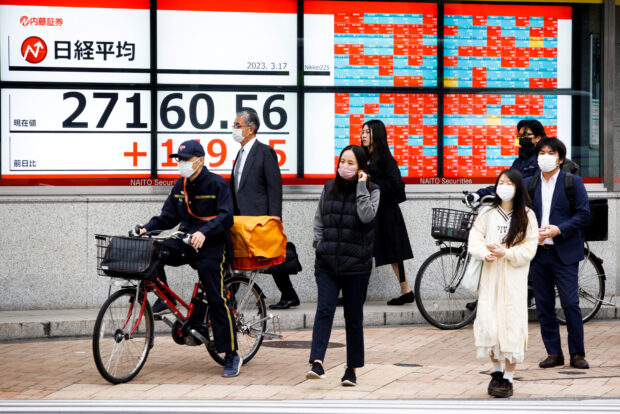
Passersby wait at a crossing in front of an electronic board showing Japan’s Nikkei average outside a brokerage, in Tokyo, Japan, March 17, 2023. REUTERS/Androniki Christodoulou/File photo
SYDNEY – Asia’s shares pared losses on Tuesday as China’s economy recorded a stronger-than-expected recovery from punishing pandemic lockdowns last year that led to a major slowdown.
MSCI’s broadest index of Asia-Pacific shares outside Japan was down 0.2 percent, a smaller decline than the 0.4-percent fall earlier in the session.
China’s economy grew 4.5 percent year on year for the first quarter which eclipsed the expectations of most economists.
The currencies of Australia and New Zealand, whose exports are reliant on Chinese demand, both popped higher after the GDP data.
Hong Kong’s Hang Seng Index was down 0.4 percent in early trade on Tuesday while China’s bluechip CSI300 Index gained 0.3 percent.
“On balance, quite an encouraging report with retail sales, GDP and property sales coming in higher than expected … reinforces the story that recovery momentum post-pandemic remains intact,” said Christopher Wong, a currency strategist at OCBC in Singapore.
Separate data on March activity also released on Tuesday showed retail sales growth beat expectations and hit a near two-year high, while factory output growth also sped up.
For 2023, GDP growth was expected to pick up to 5.4 percent, a Reuters poll showed, from 3 percent last year, which was one of its worst performances in nearly half a century due to the pandemic.
China’s government has set a 5- percent target for economic growth for this year after missing the 2022 goal.
In Asian trade, the yield on benchmark 10-year Treasury notes rose to 3.5889 percent compared with its U.S. close of 3.591 percent on Monday.
The two-year yield, which rises with traders’ expectations of higher Fed fund rates, touched 4.1773 percent compared with a U.S. close of 4.188 percent.
Australian shares recouped some earlier losses but were still down 0.27 percent, while Japan’s Nikkei stock index rose 0.56%.
Australia’s central bank considered hiking rates for an 11th time in April before deciding to pause, but was ready to tighten further if inflation and demand failed to cool, minutes of the Reserve Bank of Australia’s April meeting showed.
On Wall Street, the Dow Jones Industrial Average rose 0.3 percent, the S&P 500 gained 0.33 percent and the Nasdaq Composite gained 0.28 percent.
“The possibility of further tightening of Federal Reserve policy resulted in Treasury yields lifting while U.S. equity markets were relatively subdued,” ANZ economists wrote on Tuesday.
Two key business surveys for the U.S. published on Monday, including the Empire State Survey, showed business conditions and sentiment remained robust despite the banking sector crisis and tightening monetary policy conditions.
European stocks ended just barely lower to snap a five-session streak of gains, with the pan-European STOXX 600 index down 0.01 percent.
The winning streak was the longest for the index in three months.
The dollar rose 0.04 percent against the yen at 134.51, still some distance from its high this year of 137.91 hit in March.
The European single currency was flat on the day at $1.0929, having gained 0.77 percent in a month, while the dollar index, which tracks the greenback against a basket of currencies of other major trading partners, was down at 102.06.
U.S. crude ticked up 0.25 percent to $81.03 a barrel. Brent crude rose to $84.95 per barrel.
Gold was slightly high with the spot price at $1997.09 per ounce.

